Paz de las Aves and Papallacta
Paz de las Aves
Wednesday, July 13, 2011: We drove over to Paz de las Aves early in the morning. Angel himself led us down the trail to the Cock-of-the-Rock lek. He went down pretty quickly. In spite of his occasional stops, I was having a hard time keeping up. The rest of the group followed behind, some of them well behind. When we arrived at the lek we found a National Geographic group already there. They seemed to be high-schoolers learning about nature and photography.
The Cocks-of-the-Rock where sometimes visible, and we watched for a while. Then we went in search of the Giant Antpitta. At Paz de las Aves, Angel or his brother call in the antpittas. Once they appear, they are eventually rewarded with some worms, which they gobble up. As expected, the Giant Antpitta did appear (2 of them). One of them took most of the worms, chasing the other when it tried to come in. Eventually, Angel got between so that both would get something.
We had heard Dark-backed Wood-Quail, but they could not be enticed in. A Rufous-breasted Antthrush appeared near the second antpitta site, and we were soon torn between watching it and the Ochre-breasted Antpitta. We also spotted Violet-tailed Sylph as we walked through the woods, perhaps near the Ochre-breasted. We also encountered Tyrannine Woodcreeper. We ascended further to the Moustached Antpitta location. It too appeared on cue.
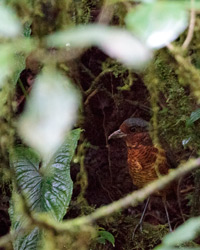 |
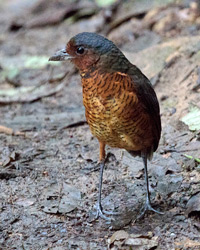 |
| Giant Antpitta in Shadows | Giant Antpitta |
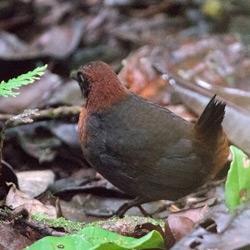 |
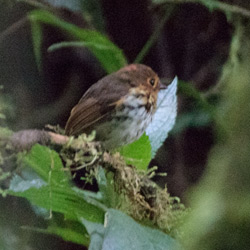 |
| Rufous-breasted Antthrush | Ochre-breasted Antpitta |
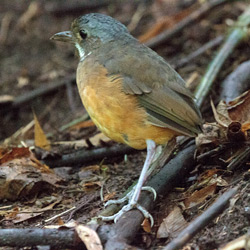 |
|
| Moustached Antpitta | |
Angel has some hummingbird feeders near the top. Those added Empress Brilliant, Velvet-purple Coronet, and Brown Inca to our list. Finally, we reached the top. The NGS group was already there, eating. A table was free, and we sat down for a second breakfast. While we were there, we noticed an American Kestrel on the wire. We also saw Black Phoebe at Paz de las Aves, perhaps from this lookout.
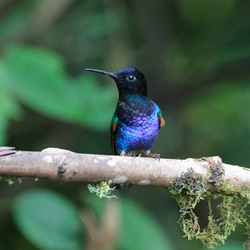 |
 |
| Velvet-purple Coronet | Green-crowned Brilliant |
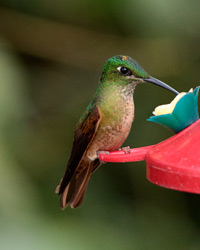 |
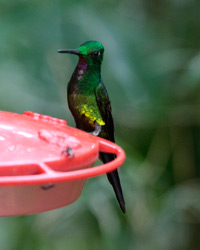 |
| Fawn-breasted Brilliant | Empress Brilliant |
We weren't done yet with the antpittas. Angel's brother joined us as we drove down the road. We then walked past a pig farm, and Angel's brother conjured up another antpitta, Yellow-breasted Antpitta. We continued to bird the area, finding a Crimson-rumped Toucanet. There was a small flock there, and we soon added additional new birds including Golden-naped Tanager, Three-striped Warbler (I only heard it), and Streak-capped Treehunter. A female Orange-breasted Fruiteater was on a nest nearby, and the male was also within sight. A Toucan-Barbet soon appeared in the same tree. We also found another flock there, but although it gave us better looks at some birds, it did not provide additional trip-birds.
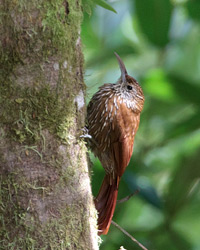 |
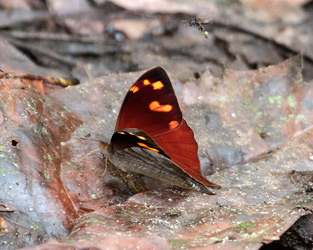 |
| Montane Woodcreeper | Butterfly |
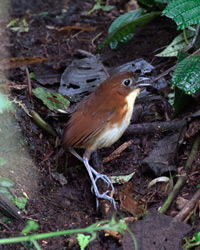 |
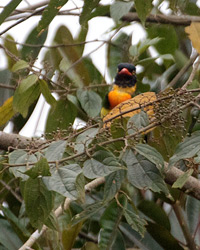 |
| Yellow-breasted Antpitta | Orange-breasted Fruiteater |
Calacali
By then it was time to leave, and we started back toward Quito. We made a stop at an area called Calacali. I missed the Common Ground-Doves, but did see the Ash-breasted Sierra-Finch, Hooded Siskin, White-tailed Shrike-Tyrant, Band-tailed Seedeater, Tufted Tit-Tyrant, Spot-billed Ground-Tyrant, and Black-tailed Trainbearer, which flew over looking somewhat like a giant dragonfly. The Calacali area is above and not far from the equator monument.
On to Guango
We continued past the monument toward Quito, eventually passing east of downtown and toward Cumbaya (yes, its a real town name). We continued upslope to the Papallacta Pass. At various points along this stretch we saw what looked like a roadbed off to the right. Apparently it is what's left of the old dirt road that Brian took on his trip here in 2002. Once over the pass, we encountered evidence of serious flooding on the road, with mudslides partially blocking the road and water still running down it. Most of us were surprised that Guango Lodge is located right next to the road. We had some sunlight left to check out the hummingbird feeders. The hummingbirds here are amazingly used to people. They will visit the feeder even if you are standing right next to it. I'd never seen anyplace before where you could photograph the hummers with a macro lens! We added Long-tailed Sylph, Chestnut-breasted Coronet, and Tourmaline Sunangel to our list before it was time for dinner.
The lodge itself is rather nice, and I think most of us were disappointed to only stay one night. The upstairs is a bit unusual. One member of our group compared it to the inside of a wine barrel. However unusual, it was nice and comfortable, albeit a little chilly at night. Fortunately, we were well provided with blankets.
My bird total for the day was 64 species, including 16 lifers. My trip total increased by 27 to 209 species, with 70 lifers.
Guango Lodge